
Ergyng (or Erging) was a Welsh kingdom of the sub-Roman and early medieval period, between the 5th and 7th centuries. It was later referred to by the English as Archenfield .

Ergyng (or Erging) was a Welsh kingdom of the sub-Roman and early medieval period, between the 5th and 7th centuries. It was later referred to by the English as Archenfield .
The kingdom lay mostly in what is now western Herefordshire (now in England), its heartland between the River Monnow and River Wye. However, it also spread into modern Monmouthshire and east of the Wye, where sits the old Roman town of Ariconium (Welsh: Ergyng) at Weston under Penyard from which its name may derive; it may have been the first capital. Some maps [1] show Ergyng extending across what is now the Forest of Dean to the River Severn.
After the withdrawal of the Roman legions from Britain in 410 AD, new smaller political entities took the place of the centralised structure. The area was originally part of the Kingdom of Glywysing (modern Glamorgan) and the Kingdom of Gwent, but seems to have become independent for a period under Peibio Clafrog in the 5th or 6th century and again under Gwrfoddw Hen in the early 7th century. [2] Peibio was the grandfather of Saint Dubricius (or Dyfrig), the first Bishop of Ergyng and an important figure in the establishment of Christianity in South Wales. He founded large teaching monasteries at Llanfrother near Hoarwithy and at Moccas, and a bishopric seems to have been based at St Constantine's Church at Goodrich. [3]
Dubricius' cousin, Gwrgan Fawr (the Great) was one of its most important monarchs and may have obtained sway over Glamorgan as far as the River Neath. In the middle of the 7th century,[ dubious ] Onbraust of Ergyng married Meurig of Gwent, and their son Athrwys became king of both kingdoms. Ergyng eventually became a mere cantref, the Welsh equivalent of a hundred. [3]
By the 8th century, the expanding power of Mercia led to conflict with the native British, and by the 9th century the Mercians had gained control over the area and nearby Hereford. The sites of old British churches fell to Mercia, and the British became foreigners – or, in the English language, "Welsh" – in what had been their own land. [4] Compared to other areas of South Wales rather few early place names in the area have survived, for which the early arrival of the English language may be partly responsible. [5] The rump of Ergyng then became known to the English as Arcenefelde or Archenfield. Although its Welsh-speaking inhabitants retained special rights, the area was unequivocally incorporated into the English county of Hereford in the Laws in Wales Acts of 1535 and 1542.
Archenfield was still Welsh enough in the time of Elizabeth for the bishop of Hereford to be made responsible together with the four Welsh bishops for the translation of the Bible and the Book of Common Prayer into Welsh. Welsh was still commonly spoken here in the first half of the nineteenth century, and we are told that churchwardens’ notices were put up in both Welsh and English until about 1860. [6]
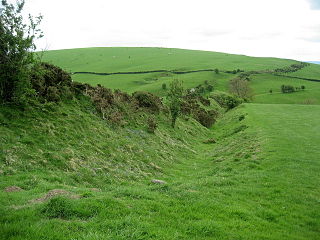
Offa's Dyke is a large linear earthwork that roughly follows the border between England and Wales. The structure is named after Offa, the Anglo-Saxon king of Mercia from AD 757 until 796, who is traditionally believed to have ordered its construction. Although its precise original purpose is debated, it delineated the border between Anglian Mercia and the Welsh kingdom of Powys.

Kilpeck is a village and civil parish in the county of Herefordshire, England. It is about nine miles (14 km) southwest of Hereford, just south of the A465 road and Welsh Marches Line to Abergavenny, and about five miles (8 km) from the border with Wales. On 1 April 2019 the parishes of Kenderchurch, St Devereux, Treville and Wormbridge were merged with Kilpeck.
The Welsh Marches is an imprecisely defined area along the border between England and Wales in the United Kingdom. The precise meaning of the term has varied at different periods.
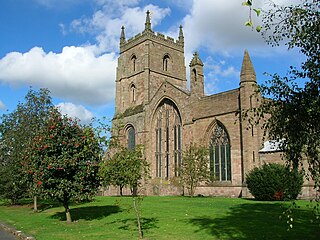
Leominster is a market town in Herefordshire, England; it is located at the confluence of the River Lugg and its tributary the River Kenwater. The town is 12 miles north of Hereford and 7 miles south of Ludlow in Shropshire. With a population of 11,700, Leominster is the largest of the five towns in the county; the others being Ross-on-Wye, Ledbury, Bromyard and Kington.

Weston under Penyard is a small village in Herefordshire, England. The population of the civil parish at the 2011 Census was 1,007.

Whitchurch is a village in Herefordshire situated on the A40, connecting nearby Ross-on-Wye to Welsh town Monmouth. It is located within the Wye Valley Area of Outstanding Natural Beauty.
The history of Herefordshire starts with a shire in the time of King Athelstan, and Herefordshire is mentioned in the Anglo-Saxon Chronicle in 1051. The first Anglo-Saxon settlers, the 7th-century Magonsætan, were a sub-tribal unit of the Hwicce who occupied the Severn valley. The Magonsætan were said to be in the intervening lands between the Rivers Wye and Severn. The undulating hills of marl clay were surrounded by the Welsh mountains to the west; by the Malvern Hills to the east; by the Clent Hills of the Shropshire borders to the north, and by the indeterminate extent of the Forest of Dean to the south. The shire name first recorded in the Anglo-Saxon Chronicle may derive from "Here-ford", Old English for "army crossing", the location for the city of Hereford.
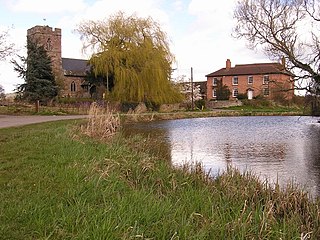
Preston on Wye is a village and civil parish in Herefordshire, England. It is situated near the River Wye, about 9 miles west of Hereford. Nearby places are Monnington on Wye, Lulham and Moccas.

Archenfield is the historic English name for an area of southern and western Herefordshire in England. Since the Anglo-Saxons took over the region in the 8th century, it has stretched between the River Monnow and River Wye, but it derives from the once much larger Welsh kingdom of Ergyng.

Dubricius or Dubric was a 6th-century British ecclesiastic venerated as a saint. He was the evangelist of Ergyng and much of south-east Wales.
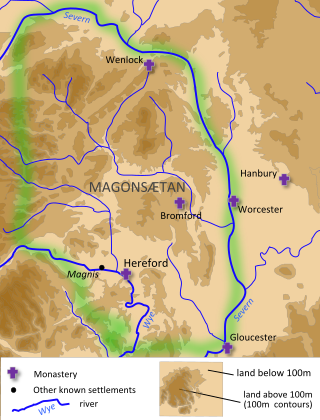
Magonsæte was a minor sub-kingdom of the greater Anglo-Saxon kingdom of Mercia, thought to be coterminous with the Diocese of Hereford.

Gwent was a medieval Welsh kingdom, lying between the Rivers Wye and Usk. It existed from the end of Roman rule in Britain in about the 5th century until the Norman invasion of Wales in the 11th century. Along with its neighbour Glywyssing, it seems to have had a great deal of cultural continuity with the earlier Silures, keeping their own courts and diocese separate from the rest of Wales until their conquest by Gruffydd ap Llywelyn. Although it recovered its independence after his death in 1063, Gwent was the first of the Welsh kingdoms to be overrun following the Norman conquest.
Devereux is a Norman surname found frequently in Ireland, Wales, England and around the English-speaking world. Saint Devereux Church in Hereford, United Kingdom is also named Saint Dubricius and is dedicated to the 6th century clergyman Saint Dubricius from Hereford, suggesting that the name is a Norman French rendering of Dubricius or the saint's Welsh name Dyfrig. In Ireland, the name is associated with Wexford, where the Cambro-Normans first invaded from Pembrokeshire, Wales in 1170. Devereux is more probably the Anglo-Norman form of D'Evreux / Devreux, meaning d'Évreux. Anglo-Norman develops regularly a svarabakhti vowel /e/ between /v/ and /r/, such as in overi, or livere. Dubricius is called Dubrice in French and Dyfrig would have given *Difry / *Dufry in French and *Difery / *Dufery in Anglo-Norman, and St. Devereux is probably a mistranslation after the surname Devereux. The French variant is Devreux, which unlike Devereux is found within Normandy and France themselves.
Ewyas was a possible early Welsh kingdom which may have been formed around the time of the Roman withdrawal from Britain in the 5th century. The name was later used for a much smaller commote or administrative sub-division, which covered the area of the modern Vale of Ewyas and a larger area to the east including the villages of Ewyas Harold and Ewyas Lacy.

Ariconium was a road station of Roman Britain mentioned in Iter XIII of the Iter Britanniarum of the Antonine Itineraries. It was located at Bury Hill in the parish of Weston under Penyard, about 3 miles (5 km) east of Ross on Wye, Herefordshire, and about 15 miles (24 km) southeast of Hereford. The site existed prior to the Roman era, and then came under Roman control. It was abandoned, perhaps shortly after 360, but precisely when and under what circumstances is unknown.
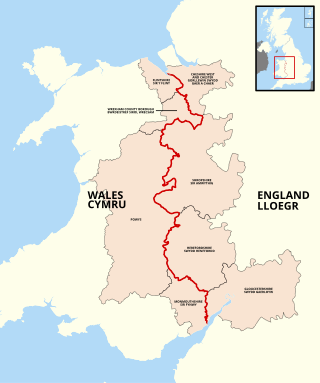
The England–Wales border, sometimes referred to as the Wales–England border or the Anglo-Welsh border, runs for 160 miles (260 km) from the Dee estuary, in the north, to the Severn estuary in the south, separating England and Wales.

St Weonards is a village and civil parish in Herefordshire, England, located 10 miles (16 km) south of Hereford, 7 miles (11 km) west of Ross-on-Wye and 8 miles (13 km) north of Monmouth, on the A466 road. Within the parish and also on the A466 is the hamlet of Sandyway. St Weonards lies within the area known to the Saxons as Archenfield, previously the kingdom of Ergyng, adjoining the modern border with Wales. Ergyng was later reduced to a semi-autonomous cantref retaining Welsh language and customs until the early nineteenth century.
Cyfeilliog was Bishop of Ergyng and probably Gwent in south-east Wales. He is recorded by the mid-880s in the Llandaff Charters and in 914 he was captured by the Vikings and ransomed by Edward the Elder, King of the Anglo-Saxons, for 40 pounds. He is probably the author of a cryptogram in the Juvencus Manuscript which would have required a knowledge of Latin and Greek.
Cantref Coch was a cantref associated with the kingdoms of Ergyng, Gwent and the later Kingdom of Glamorgan. Its area is defined as the land between the River Severn and the River Wye, with the Severn Sea as its southern border although its northern border is less certain. Cantref Coch is one of the few medieval cantrefi named by Welsh writers that is not within the modern nation of Wales.